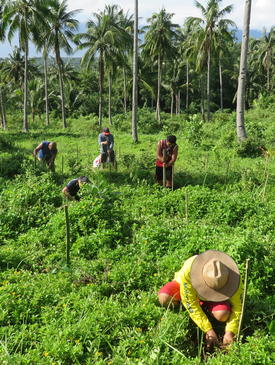Rainforestation Training for Climate-Resilient Recovery
Summary
In 2013, one of the strongest tropical cyclones ever recorded hit the central Philippines. Super typhoon Haiyan wreaked havoc in many areas in Samar and Leyte Island, causing millions of casualties and damages. Damage in agriculture, particularly in coconut production, affected the livelihoods of over a million farmers in the Philippines. Some farmers have replanted their lands with seedlings, but they still need to wait six to eight years for the trees to become productive. In the meantime, farmers are intercropping with vegetables and fruit trees for subsistence and short-term income sources.
Rehabilitating natural ecosystems is crucial in post-disaster recovery to support human livelihoods and to sustain the delivery of ecosystem goods and services, including a steady supply of water and protection from future extreme weather events. This is an integral part of a climate-resilient recovery strategy, in which communities are not only provided with assistance to recover from extreme climatic events but are also better equipped to deal with future disasters.
ELTI and ITEEM-VSU will conduct a Rainforestation training series in Samar and Leyte to address this gap in rehabilitation efforts. The series will rehabilitate damaged watershed areas and augment the current farming system in the surrounding areas using the Rainforestation approach. Developed by ITEEM-VSU, Rainforestation is a participatory strategy to implement reforestation with native species and agroforestry systems. The training will include a discussion of the results of the post-disaster site assessment, participatory watershed rehabilitation planning, individual farm plans and a hands-on demonstration of nursery practices. This training series will contribute to the long-term rebuilding and “building back better” initiative in the region.
Content
Day 1:
- Introduction to Philippine biodiversity
- Introduction to Rainforestation and development of a climate-resilient agroecological production system
- Lecture on fruiting phenology, propagation techniques and nursery establishment
Day 2:
- Demonstration and hands-on exercises on chambering and nursery management
- Establishment of a demonstration site in Palapag
Day 3:
- Farm planning workshop and consultation with experts
- Closing of the program


